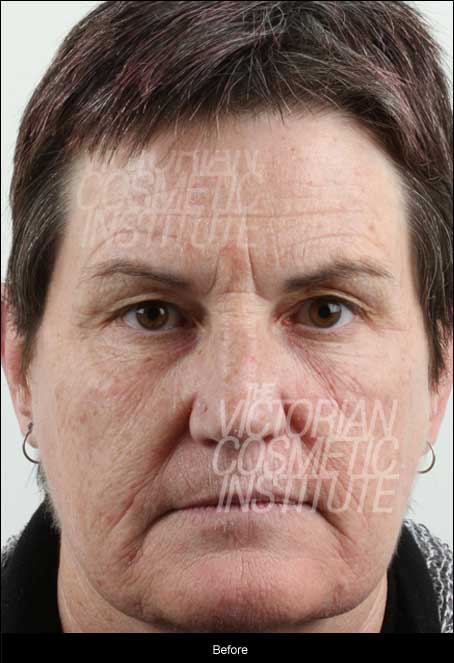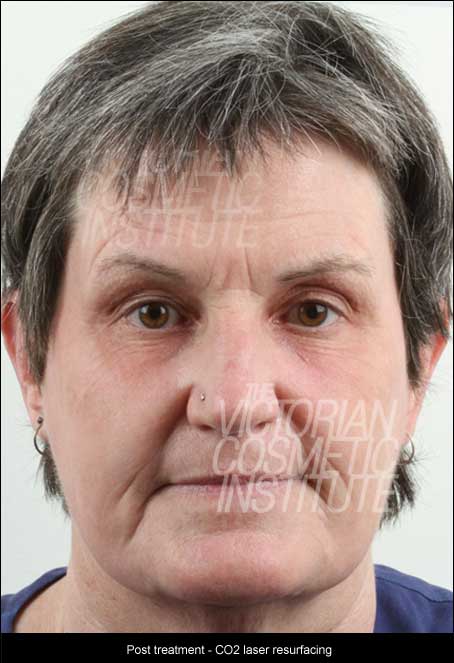Skin Resurfacing Treatment Melbourne
What is skin resurfacing?
Skin resurfacing refers to the process of removing and stimulating the regeneration of skin through controlled ablation and thermal activation. This can be achieved using various methods, including laser technology, chemical peels, plasma energy, or mechanical techniques, each selected based on the specific needs of the skin and desired outcomes.
Skin resurfacing can help with:
- Deep wrinkles
- Fine lines
- Scarring
- Acne scarring
- Uneven skin tone
- Uneven texture
- Freckles
- Sun damaged skin
Skin resurfacing treatments encourage new collagen formation and these new skin cells help reinvigorate the skin, resulting in a more refreshed appearance.
Why is skin resurfacing performed?
Skin resurfacing is performed to improve the overall quality, texture, and appearance of the skin. By removing damaged surface layers and stimulating the skin’s natural healing response, resurfacing treatments encourage the production of new collagen and healthier skin cells. As a result, the skin gradually becomes smoother, more even, and more radiant.
Furthermore, because each patient’s skin concerns and goals are unique, skin resurfacing can be tailored in depth and technique to address specific issues while supporting long term skin health.
Some examples of what skin resurfacing is used to treat include:
- Wrinkle treatment
- Improving skin texture
- Skin tightening
- Reversing sun damage
- Correcting pigmentation
- Reducing acne scars
- Generating new skin cells
- Stimulating collagen and elastin
How are skin resurfacing treatments performed?
Skin resurfacing can be performed in a number of ways. Essentially, all methods involve removing layers of the skin, whether it be with a laser, chemical peel, or by mechanical means.
In most cases, the procedure results in dramatic improvements in the skin wrinkling, texture, skin tightness, pigmentation, and acne scarring, but requires a period of downtime or recovery.
Generally, more aggressive skin resurfacing procedures are associated with longer downtime, but they also tend to deliver more noticeable results. However, advancements in technology, particularly the development of fractional laser systems, have aimed to challenge this balance by offering effective outcomes with significantly reduced recovery periods.
To a considerable extent, this has been achieved. These newer technologies allow for substantial improvements in skin quality with minimal compromise in effectiveness. Additionally, by treating only a fraction of the skin at a time while leaving surrounding tissue intact, fractional methods have contributed to faster healing and lower risk profiles, making it possible to achieve meaningful results with greater safety and comfort.
What are the different types of skin resurfacing treatments?
There are multiple treatments available that can provide skin resurfacing functions. Some examples include:
Dermabrasion
One of the first methods used to resurface skin was dermabrasion. This involves mechanical sanding (using a machine) of the skin under general anaesthesia. It should not be confused with microdermabrasion which is a very gentle procedure. True dermabrasion was commonly used for acne scars and wrinkles, but has since fallen out of vogue due to the high risk of scarring, pigmentation changes, and prolonged recovery (months) from the procedure.
Chemical Peels
Chemical peels are also a means of resurfacing the skin and these have been performed for many years. Particular peeling agents are used to remove and resurface layers of the skin. Generally, these are strong acids such as trichloroacetic acid or phenol, and when used in a controlled manner in a standardised setting, the results can be safe and effective.
However, the results from peels are very operator and peel dependent. As they can be performed without the need of expensive equipment, peels tend to be very cost effective in comparison to other methods of skin resurfacing. A course of chemical peels such as lactic acid and salicylic acid can be used in lower concentrations to reduce the downtime required between treatments.
Co2 Laser
The carbon dioxide (CO2) laser is a fully ablative skin resurfacing laser. The Co2 laser tends to remove a layer of skin with each pass, and causes some thermal injury or heating of the skin to help produce tissue contraction or tightening. The results are considered to be the ‘gold standard’ for laser resurfacing, but often Co2 laser resurfacing results in prolonged recovery periods, skin redness, scarring, an unnatural ‘waxy’ looking appearance to the skin, and gradual loss of pigmentation in the skin (hypopigmentation). This procedure is performed in a surgical setting under anaesthesia and requires significant downtime.
Erbium Laser
To combat the problems of the Co2 laser, erbium lasers were introduced as an alternative. It requires a more acceptable recovery period as well as fewer side effects, whilst still being an effective means of laser resurfacing.
Due to the heating of the skin, Co2 lasers cause more skin contraction and tightening than erbium lasers. The erbium laser removes a very thin slice off the top layers of the skin to resurface it, but does so without much thermal energy. Usually multiple passes are required to achieve an adequate penetration depth. Recovery is quicker with erbium laser resurfacing, but there is not as significant skin contraction or results as with the Co2 laser.
Fractional Laser
More recently, laser treatments using fractional laser resurfacing have emerged as an alternative to traditional carbon dioxide or erbium laser resurfacing. As the name suggests, fractional lasers treat only a certain percentage of the skin. They achieve this by firing columns of laser energy into the skin, and leaving the skin adjacent to the columns relatively unaffected. This reduces the recovery period of the procedure, reduces the risks of the procedure, but also to some extent reduces the effectiveness of the procedure. For many patients, this is a viable compromise, given the potentially long recovery periods associated with fully ablative carbon dioxide or erbium laser resurfacing.
Fractional laser resurfacing provides an excellent balance between recovery times, risks, and results.
Table: A comparison of the various skin resurfacing procedures available
| Procedure | Dermabrasion | Chemical peel | CO2 laser | Fractional CO2 | Erbium laser | Plasma skin regeneration |
| Results | ++++ | +++ | +++++ | ++++1/2 | +++ | +++ |
| Downtime | +++++ | +++ | +++++ | ++ to +++ | +++ | ++++ |
| Risks | +++++ | +++ | ++++ | ++ | +++ | ++++ |
| Costs | +++++ | + | ++ | ++++ | ++++ | ++++ |
What is the difference between laser skin resurfacing and non-laser resurfacing?
The goal of skin resurfacing is to eliminate the dead layers of skin to reveal smoother and tighter skin underneath. Both resurfacing lasers and non-laser resurfacing treatments can do this.
Laser resurfacing procedures penetrate deeper into the skin by using heat that evaporates the skin tissue to remove the outer skin layers. As the skin tissue has been evaporated, it results in new collagen production and as a result texture, tightness and colour are improved. Laser treatments can be ablative, non-ablative or fractional.
Non-laser resurfacing uses chemicals or mechanical facial tools to resurface the skin. Whether it is a chemical peel or dermabrasion, the chemical solution or skin resurfacing tool is applied to the skin and removes the skin from the treated area to reveal brighter and smoother skin.
What is involved with skin resurfacing?
In most cases, it will involve preparation of the skin prior to treatment. This may involve sun avoidance, using sunscreens, topical retinoids, or topical lightening agents. These help to reduce the potential risks of resurfacing including pigmentary changes or scarring.
The procedure itself usually requires some form of analgesia/anaesthesia, and the degree of analgesia/anaesthesia required will depend on the depth or intensity and the treated area of the resurfacing. It can range from as little as numbing cream to as much as intravenous sedation with local anaesthetic injections.
After skin resurfacing, there is usually a recovery period of several days to weeks. Again this will depend on the type of procedure, and the depth and intensity of the procedure performed. Usually there is a degree of skin redness, swelling, crusting, and peeling that occurs. Skin usually needs to be kept moist with balms or vaseline during the pre-peel phase. Sun avoidance and gentle cleansing of the skin is also important during this time.
FAQ
Which resurfacing treatment has the least amount of downtime?
Chemical peels, fractional Co2 laser and Erbium laser tend to have the least amount of downtime. When choosing the appropriate skin resurfacing treatment, it should be based on which treatment best suits your needs, rather than which has the least amount of downtime.
What are the benefits of non-laser skin resurfacing treatments?
Some benefits of non-laser resurfacing treatments include, less invasive procedure, shorter recovery time, reduction in wrinkles, minimised pigmentation, smoother skin, even skin tone and decreased scarring.
Who is a suitable candidate for laser treatments?
Laser resurfacing is ideal for someone who is in general good health. They may want to treat wrinkles or fine lines around their mouth, eyes or forehead, acne scars and textural irregularities. If you are unsure of whether you would be a good candidate for laser treatments, a consultation with our team can help you.
Is it safe to have laser resurfacing when pregnant?
It is generally not advised to have laser treatment when pregnant as this can lead to permanent discolouration of the skin. For aesthetic skin treatments, it is recommended to wait at least six months post-pregnancy, before seeking any treatment as these symptoms generally fade over time.
What are the benefits of laser resurfacing treatments?
There are many benefits to laser skin resurfacing, including reduced wrinkles and fine lines, treatment of brown spots, redness or skin discolouration, tightening of the skin and new collagen production, improved acne, traumatic or surgical scars and a more even skin tone.
What is the best laser resurfacing treatment?
This will depend on your concerns, the amount of downtime required and the desired outcome. A consultation with our team can determine what the most suitable laser resurfacing treatment is for your concerns and skin type.
Why choose The Victorian Cosmetic Institute as your provider of skin resurfacing treatments?
For over 20 years Victorian Cosmetic Institute have used a combination of fractional carbon dioxide, and erbium laser resurfacing to resurface the skin. Using our experience and knowledge, we are able to provide you with the suitable laser and settings for your skin and appropriate follow-up for your procedure.
Our treatments are performed by doctors, and we take the time to assess your skin and discuss and understand your cosmetic goals.
Contact our Customer Care team on 1300 863 824 to schedule your initial consultation, where we will discuss with you what is a realistic and achievable outcome, and what to expect from your treatment. Alternatively, you can book your appointment online.
Last updated May 2025


